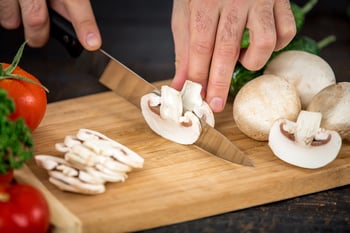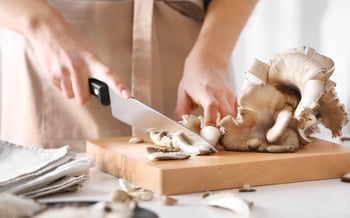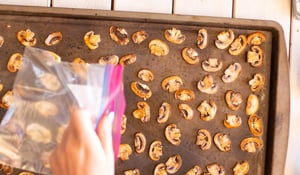Description
The grilled mushroom bibimbap bowl features an assortment of sauteed mushrooms and quick pickled vegetables for a fresh but filling Korean-inspired meal.Ingredients
- 1 lb. Mung bean sprouts
- 4 Tbsp. sesame oil, divided
- 1⁄2 tsp. salt
- 2 Tbsp. garlic, finely minced, divided
- 6 green onion, sliced
- 12 oz. spinach (with tender stems)
- 24 oz. assorted mushrooms, such as Monterey® Baby Bella, Oyster, White, Portabella, and Shiitake Mushrooms
- 2 oz. soy sauce
- 1 1⁄2 oz. honey
- 3 cups short grain brown rice, uncooked
Quick Pickled Vegetables
- 6 oz. carrot, cut into matchsticks
- 6 oz. zucchini, thinly sliced into half moons
- 3 oz. red radish, thinly sliced into half moons
- 6 oz. red bell pepper, cut into matchsticks
- 6 oz. cucumber, cut into matchsticks
- 2 tsp. salt
Garnish
- 4-6 Tbsp. gochujang
- 4-6 egg yolks or sunny side up egg
- Toasted sesame seeds as needed
- Gochugaru as needed
Instructions
- For Quick Pickled Vegetables: Place carrots in small bowl, sprinkle with 1⁄2 tsp. of salt, and set aside.
- Place zucchini and radish together in small bowl, sprinkle with 1⁄2 tsp. of salt, and set aside.
- Place bell pepper in small bowl, sprinkle with 1⁄2 tsp. of salt, and set aside.
- Place cucumber in small bowl, sprinkle with 1⁄2 tsp. of salt, and set aside.
- Allow pickles to marinate for 20 - 30 minutes, squeeze water out of carrots, zucchini, radish, and cucumber quick pickles, keeping them separate.
- For Bean Sprouts: Place bean sprouts in medium saucepan and cover with water and lid. Boil without lifting lid, and cook for 10 minutes. Drain and toss with sesame oil, 1⁄2 tsp. of salt, 1 tsp. garlic, and 1⁄2 green onions. Set aside.
- For Spinach: Heat medium saucepan. Wash spinach 3 times, immediately remove from water to pan without drying. Add 1 tsp. of garlic and place lid on pot. After 2 minutes, stir spinach and continue to cook for 2 minutes or until spinach is wilted. Drain and allow to cool. Roughly chop and season with 1 tsp. of sesame oil and salt to taste. Set aside.
- Heat non-stick pan and sauté bell peppers. Add 1 tsp. of sesame oil and remaining green onions. Wipe pan out and sauté all salted vegetables separately, add in 1 tsp. of sesame oil for each vegetable, wiping pan between uses, and placing wilted veggies back in separate small bowls, ready for assembly. Season with salt to taste.
- Depending on size of assorted mushrooms, slice, leave whole, or cut mushrooms in half so all are same size.
- Heat large sauté pan. Add canola oil and cook mushrooms in batches until deep golden brown and thoroughly cooked.
- Mix together soy sauce, honey, remaining garlic, and remaining sesame oil.
- (When mushrooms are cooked) pour sauce over mushrooms and boil. Cook until mushrooms are well coated with shiny glaze, being careful not to burn sauce.
- Assemble Bibimbap in traditional dolsot (Korean earthenware pot) coating bottom with approximately 2 tsp. of sesame oil before dividing rice between pots. (Alternatively, without traditional dolsot, this can be presented with hot rice in individual serving bowls)
- Top rice with vegetables arranged in small piles on top.
- If using dolsot, place pot on burner over medium high heat. Wait until you can hear rice sizzling and forming nurungji or traditional crust on bottom.
- Finish bibimbap with gochujang, a sprinkle of gochugaru, and roasted sesame seeds.
- Top with raw egg yolk or sunny side up egg.

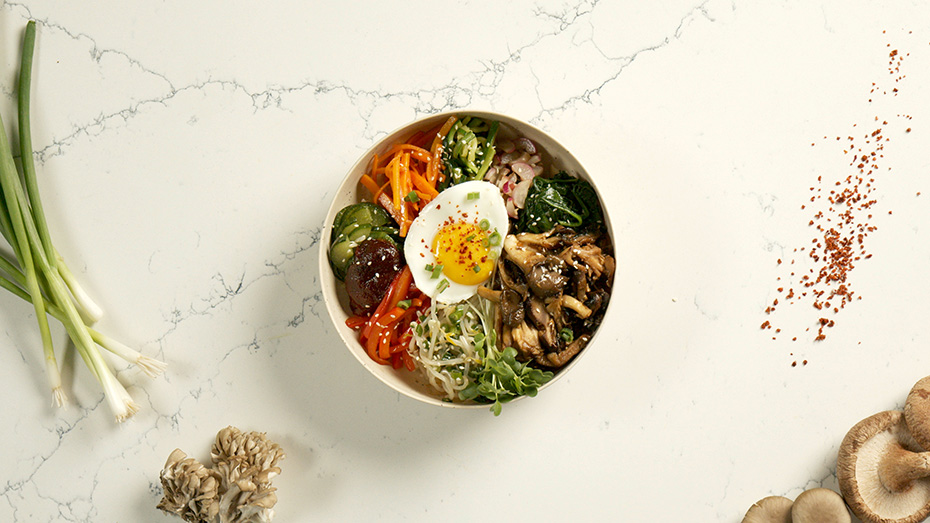


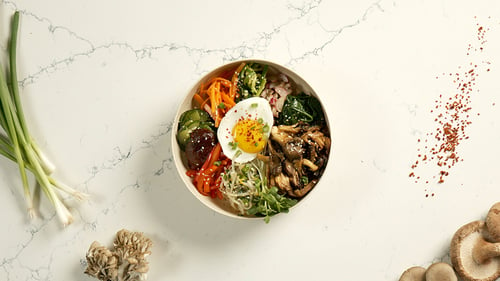
.png)


